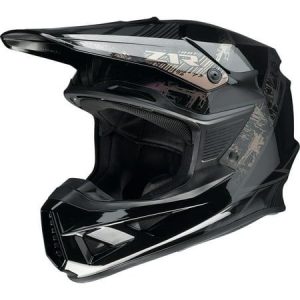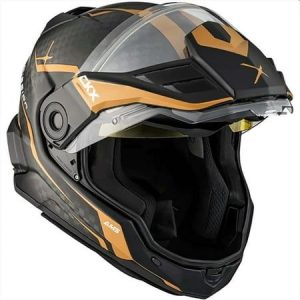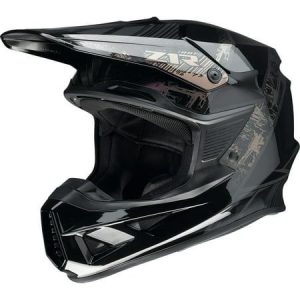Leaving your motorcycle parked unattended can be nerve-wracking, especially when it comes to your helmet. This essential piece of protective gear is vulnerable to theft, so proper locking techniques are crucial. This comprehensive guide explores various methods for locking your motorcycle helmet, along with valuable tips to maximize security and peace of mind.
Understanding the Risks: Why Locking Your Motorcycle Helmet Matters
Motorcycle helmets are a prime target for thieves due to their:

- Resale Value: High-quality helmets can fetch a decent price on the black market.
- Resale Demand: Helmets are a universal safety requirement for motorcycle riders, creating a consistent demand.
- Ease of Stealing: Unsecured helmets are relatively easy to grab and go compared to other motorcycle parts.
By taking the time to properly lock your helmet, you significantly deter theft attempts and protect your investment.
Choosing Your Weapon: Popular Motorcycle Helmet Locking Options
Now that you understand the importance of helmet security, let’s explore various locking methods:

- Cable Locks: A simple and affordable option, cable locks offer basic security. Choose a thick, braided steel cable with a loop large enough to thread through your helmet’s D-rings and secure it to a fixed part of your motorcycle. Remember, cable locks can be cut with bolt cutters, so they might not deter determined thieves.
- Disc Locks: Disc locks provide a strong visual deterrent and offer more security than cable locks. These U-shaped locks attach directly to your motorcycle’s disc brake rotor, preventing the motorcycle from rolling. While not specifically designed for helmets, you can loop a cable lock through the disc lock and your helmet’s D-rings for added security.
- Chain Locks: Thicker and sturdier than cable locks, chain locks offer significant theft protection. Look for hardened steel chains with a durable locking mechanism. Similar to cable locks, thread the chain through your helmet’s D-rings and secure it to a part of your motorcycle’s frame.
- Helmet Locks: These specialized locks are designed specifically for securing motorcycle helmets. They typically come with a cable or strap that attaches to your helmet and a locking mechanism that anchors to a fixed point on your motorcycle. Helmet locks offer a convenient and secure solution, but might be pricier than cable locks.
Choosing the Right Lock: The best locking method depends on your budget, security needs, and motorcycle type. For basic protection, a cable lock might suffice. For enhanced security, consider a disc lock or chain lock combined with a cable to secure your helmet. Helmet locks offer a convenient and user-friendly option specifically designed for securing helmets.
Beyond the Lock: Additional Security Tips for Motorcycle Helmet
While a good lock is essential, here are some additional tips to further enhance your motorcycle helmet’s security:

- Park Smart: Whenever possible, park your motorcycle in a well-lit, secure location with video surveillance. Avoid leaving it in isolated areas or for extended periods.
- Double Up on Security: Consider using a combination of locking methods for increased protection. For example, use a cable lock to secure your helmet to your motorcycle frame and a disc lock to immobilize the motorcycle itself.
- Invest in a Helmet Lock Bag: These weatherproof bags provide an extra layer of protection for your helmet while it’s locked to your motorcycle. They also help deter potential thieves by obscuring your helmet from view.
- Take Your Helmet with You: If possible, especially in high-risk areas, consider taking your helmet with you when leaving your motorcycle unattended for short periods.
No locking method is foolproof. By implementing a combination of these strategies, you can significantly reduce the risk of your helmet being stolen.
Locking Techniques: Putting it into Practice
Here’s a step-by-step guide on how to use a cable lock to secure your motorcycle helmet:
- Find a Secure Anchor Point: Locate a solid part of your motorcycle frame, such as the frame itself, a swingarm, or a footpeg. Ensure the chosen point is strong enough to withstand potential pulling or yanking.
- Loop the Cable: Thread the cable lock through your helmet’s D-rings, ensuring both rings are secured within the loop.
- Attach to Anchor Point: Wrap the remaining cable around the chosen anchor point on your motorcycle frame and secure it with the locking mechanism of the cable lock.
- Lock it Up: Lock the cable according to the manufacturer’s instructions. Double-check that the lock is securely fastened and cannot be easily removed.
For additional locking methods:

- Disc Locks: Follow the specific instructions that come with your disc lock to properly attach it to your motorcycle’s disc brake rotor. Remember, a disc lock alone doesn’t secure your helmet. You can loop a cable lock through the disc lock and your helmet’s D-rings for added security.
- Chain Locks: Similar to cable locks, thread the chain through your helmet’s D-rings and secure it to a sturdy part of your motorcycle’s frame. Ensure the chain is long enough to comfortably loop through both D-rings and around the chosen anchor point.
- Helmet Locks: These typically come with a cable or strap that attaches to your helmet’s D-rings. Consult the manufacturer’s instructions for specific attachment methods. Locate a designated secure anchor point on your motorcycle frame (often near the seat or passenger footpeg) and fasten the locking mechanism of the helmet lock to this point.
Regardless of the locking method you choose, practice using it beforehand to ensure you can secure your helmet quickly and efficiently.
Invest in Your Security: Upgrading Your Locking Options
While basic cable locks offer some protection, consider investing in a more robust locking solution for enhanced security:
- High-Quality Cable Locks: Opt for a braided steel cable with a larger diameter, making it more difficult to cut through with bolt cutters.
- Disc Lock Alarms: Disc locks with integrated alarms provide an audible deterrent if someone attempts to tamper with the lock.
- Locking Helmet Bags: These weatherproof bags offer additional protection from the elements and can potentially deter theft by concealing your helmet.
A higher-quality lock makes it more challenging for thieves and offers greater peace of mind.
The Insurance Advantage: Motorcycle Helmet Coverage and Peace of Mind
In addition to physical security measures, consider motorcycle insurance that covers helmet theft. Here’s what to know:

- Comprehensive Coverage: Comprehensive motorcycle insurance typically covers theft of your helmet, along with other motorcycle parts and accessories.
- Check Your Policy: Review your existing motorcycle insurance policy to determine if helmet theft is covered and understand any deductible amounts that might apply.
- Consider Upgrading Coverage: If your current policy doesn’t cover helmet theft, speak with your insurance provider about adding comprehensive coverage for added peace of mind.
While insurance can help recoup financial losses in case of theft, preventing theft in the first place is always preferable.
Lock It Up and Ride with Confidence
By following the tips and strategies outlined in this guide, you can significantly enhance your motorcycle helmet’s security and deter potential theft attempts. Remember to choose a locking method that suits your budget and security needs, park strategically, and consider additional security measures like helmet lock bags or insurance coverage.


